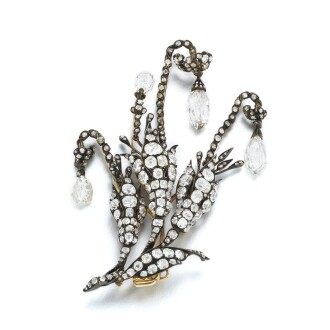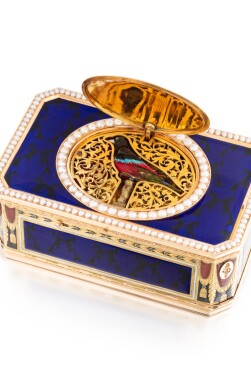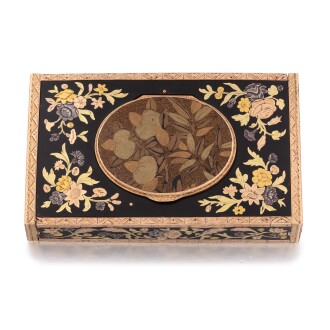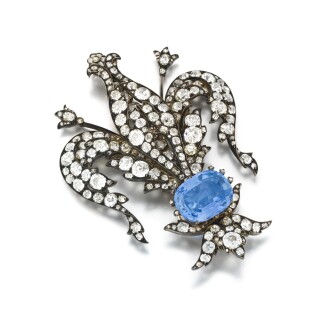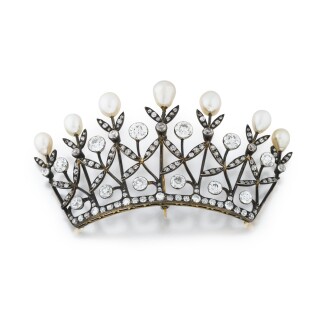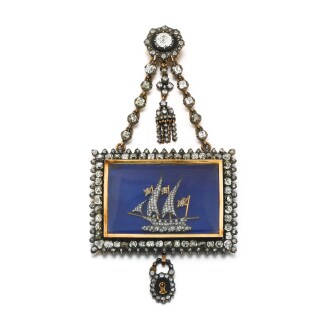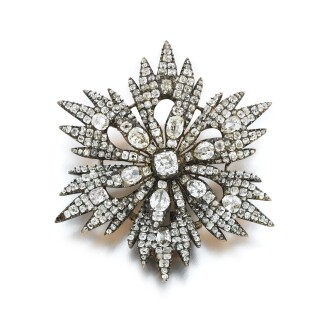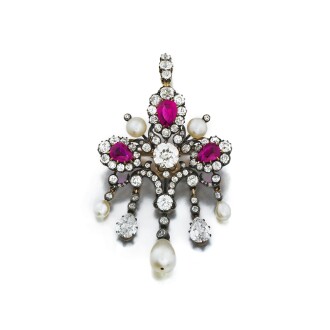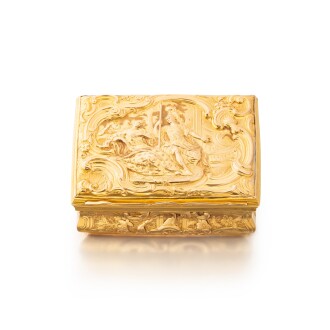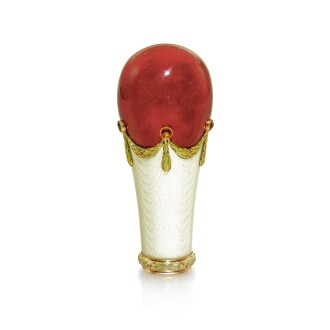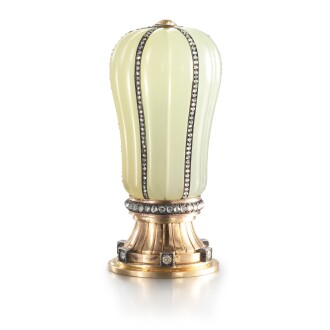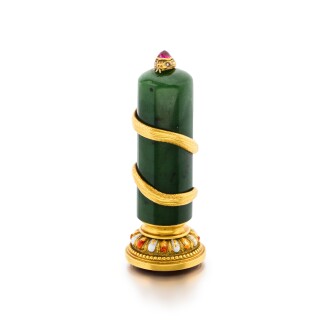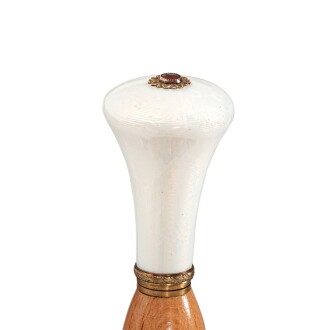W hilst the various private owners of the Hôtel maintained a decorative continuity typical of the Louis XIV, Louis XV and Louis XVI styles, His Highness Sheikh Hamad Bin Abdullah Al Thani added to this sumptuous setting by including a fascinating collection of jewels and extraordinary gold boxes spanning nearly three centuries, as well as a variety of objets d’art including splendorous Fabergé, mother of pearl fans and hardstone desk seals.
This collection of miniature treasures, acquired one by one by this discerning collector, comprises jewels dating from the Renaissance through to the 16th century, as well as jewelry from the 19th century up to the first part of the 20th century. Highlights include a series of brooches "à l'égaré" forming knots typical of the Madame de Sévigné period, and a devant de corsage with floral designs enhanced with precious stones and important natural pearls in pendant. Jewels with historical origins include a fleur-de-lys brooch set with diamonds, enhanced with an important sapphire, said to have belonged to Marie-Louise de Bourbon-Parme.
The extremely rare mid-18th century gold and lacquer necessaire-à-secret with a number of hidden compartments demonstrates the limitless inventiveness and skillfulness of the gold box makers in Paris. An early 18th century chased gold snuff boxes accompany diamond-set Royal and Imperial presentation boxes from the following century. A brightly-enamelled pearl-set singing bird box made in Geneva in the early 19th century enchants the connoisseur and the passionate amateur alike. Two gold bonbonnières by the Dresden court jeweller Johann Christian Neuber, inlaid with semi-translucent hardstone specimens, are true portable ‘bijoux’, further contributing to the lavishness of the collection of jewels and objects of Vertu at the Hôtel Lambert.
Proceeds from the sale to support The Al Thani Collection Foundation.

Auction Highlights

Jewels

Gold Boxes

Fabergé

The Schatzkammer at the Hôtel Lambert
by Vincent Meylan
Schatzkammer! This German word translates literally as “treasure room”. More than a hundred pieces of jewellery kept at the Hôtel Lambert tell the tale of three centuries of jewellery making. From the final years of the Renaissance to the beginning of the belle époque.
Two pendants that could be twins. Same Jerusalem cross shape. Same white, green and red enamel adornment. Created during the same period: circa 1625. And most importantly, from the same country of origin: Spain. This was the height of the Golden Age, a time of great political and artistic glory for the Iberian Peninsula under the reign of the last three sovereigns of the Habsburg dynasty: Philip III, Philip IV and Charles II. The easiest way to understand how these pendants were worn, is to look at a Velázquez painting. In his celebrated work Las Meninas, the young Infanta Margaret Theresa is wearing a similar accessory pinned to a red taffeta bow at the centre of her bodice. At the beginning of the 17th century in Spain, this piece was a must for all noble women. The number, size and quality of the gemstones used did vary, however. Indeed, appraisal of the two pieces in the collection at the Hôtel Lambert assigns slightly different values to them. The first is valued at 30 to 40,000 euros, while the second (set with diamonds) is worth 50 to 70,000 euros.

Over a hundred antique pieces of jewellery make up this extraordinary collection which tells the tale of the history of jewellery making in Europe from the end of the Renaissance to the beginning of the 20th century. As you would expect in such a treasure room, a great many styles, periods, technical innovations, and political and artistic influences are represented. The collection is fascinating for lovers of jewels and precious stones as well as for those eager to understand how the art of jewellery making has evolved over the centuries.
Among the oldest pieces, there are several from the beginning of the 16th century. Enamel, a stylistic hallmark of Renaissance goldsmiths – Italian, Flemish and French – holds pride of place in these pieces. This pair of round buckles, undoubtedly designed to be fastened to a coat or cape, was made in Hungary. This kingdom, whose capital at the time was Pressburg (today’s Bratislava), fell under the remarkable artistic sphere of influence exerted by the extravagant Austrian branch of the Habsburg dynasty from the end of the 16th century to the beginning of the 17th. Rudolf II, the mysterious alchemist emperor who died in 1612, was a generous patron of the arts in general, and of goldsmithery and gemstone setting in particular. The narrow street that wound around his palace in Prague was nicknamed “Golden Lane” because of all the goldsmiths who worked there.
A pendant, also made in Hungary, perfectly embodies the period. Gold and diamonds—featuring the popular table cut from the time—are used lavishly. A host of symbols adorn both sides. On the front, its shape evokes the two-headed eagle—the emblem of the Habsburgs of Austria, who had ruled over Hungary for a century at the time. On the back, its feathers are covered in black enamel. Above the heraldic animal there is a crowned cross. The allusion to the alliance between church and state is clear. Moreover, two white enamel hands wrap around the eagle, referencing an ancient symbol for loyalty – “la Foy”: two hands joined to signify the ties of love, friendship or political alliance. Below, nearly hidden beneath a gold pattern, there is a tiny white enamel skull. A Vanitas. The pendant may affirm its owner’s loyalty to the Habsburgs, whose power was still fragile in Hungary at the time.

A century later, we find ourselves in Madrid with a series of gold and emerald pieces: chandelier earrings, a pendant and a bow-shaped brooch featuring a hanging cross. Times have changed. The Habsburgs of Spain died out in 1700 with King Charles II, and a branch of France’s House of Bourbon succeeded them. Louis XIV’s grandson, Philip V, imported a very different style, complete with its own ornamentations and symbols, from Versailles. The French gardens at his palace in Aranjuez are one example. Changes in decorative arts more broadly and a more frivolous approach to jewellery in particular are others. This ensemble, which also dates back to the 18th century but hails from Lisbon, is even more exuberant. At the time, the kingdom of Portugal revelled in copious amounts of gold from Brazil. The sovereign was entitled to a fifth of all imports from the New World, for his own personal use. The jewellery worn at the Braganza court at the time was magnificent.
One important detail concerning the Portuguese pieces in the collection of the Hôtel Lambert is that they are set with diamonds. The discovery and operation of diamond mines in Brazil considerably increased the resources available to Portuguese jewellery makers. And cuts had evolved significantly since the end of the 17th century, increasing the number of facets to enhance the stones’ brilliance. Precious metals, which held a preponderant place in Renaissance and Baroque pieces, are more discreet here, to showcase the stones. One example is this 18th-century chatelaine comprising four knot-shaped elements where diamonds overshadow the rest. Diamonds are also sovereign in these silver drop earrings, and especially in this beautiful aigrette which pairs a bouquet of fuchsia with diamond briolettes. This 19th-century piece is indicative of a major stylistic shift in jewellery making. From this period on, nature becomes paramount. Leaves, flowers and bouquets are omnipresent. And they remain so today for the major Parisian jewellers.




